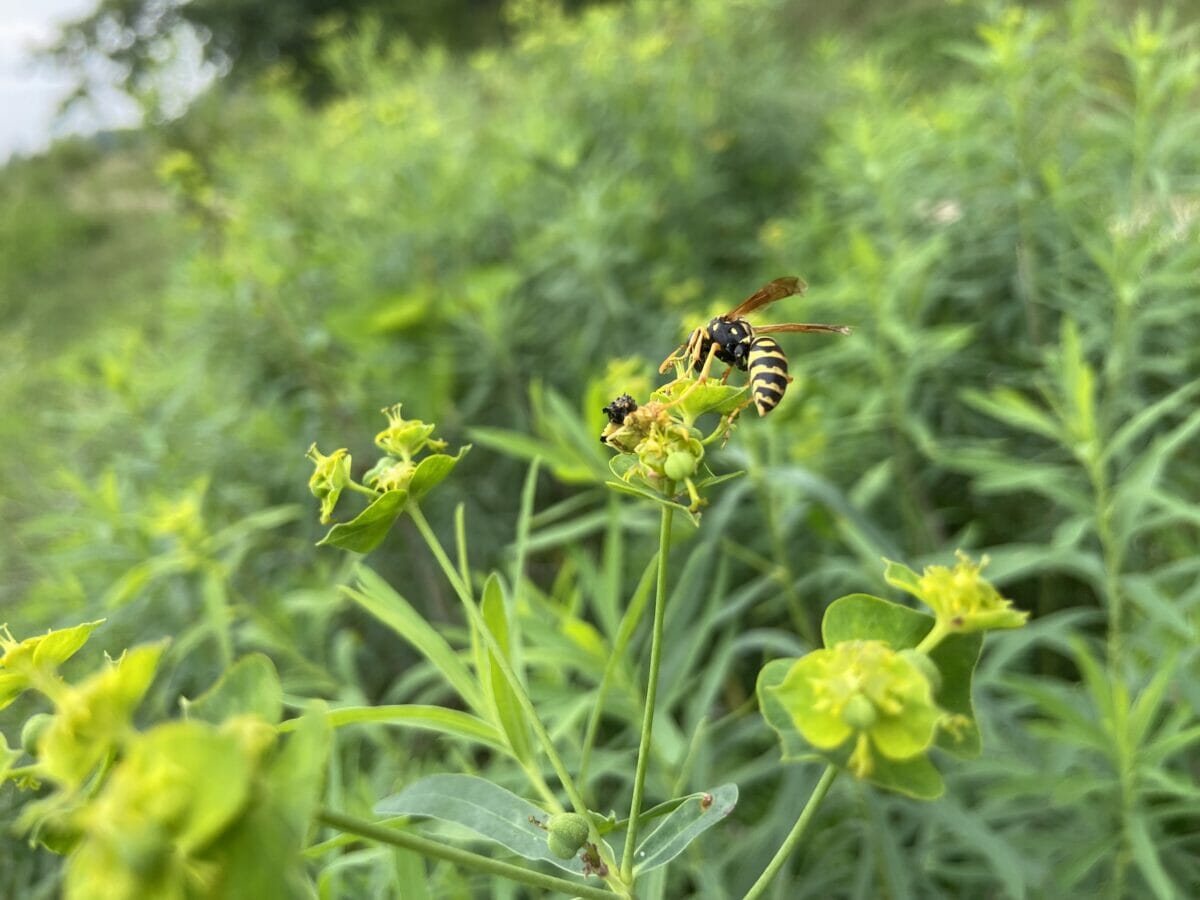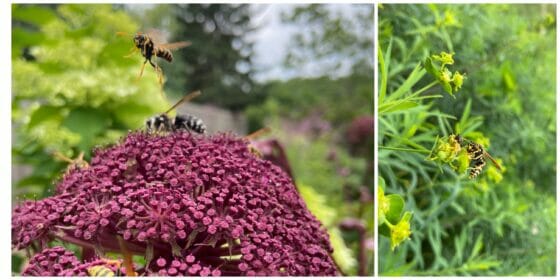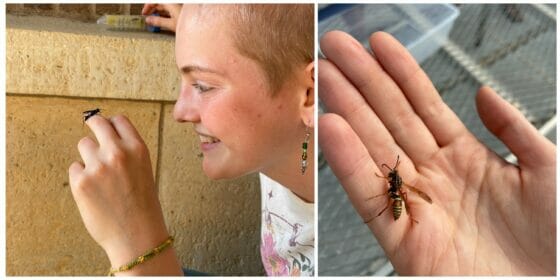In Defense of Wasps
How I fell in love with wasps. Yes, the stinging ones.
In Defense of Wasps
How I fell in love with wasps. Yes, the stinging ones.

courtesy of Anna Lovat.
When I am talking to folks about wasps, I usually have to stop a couple of times and explain that when I say I love wasps, I truly do mean wasps. Yes, the stinging ones. Yes, the ones that stung you/your brother/your great-uncle Patrick and that you hate/despise/abhor. Yes, I promise.
Wasps are an incredibly diverse species, spanning from yellowjackets to velvet ants (despite the name, they are wasps), which provide countless ecological services—including protection for agriculture via pest prevention and pollination. As wasps are predators, they hunt prey, such as flies, caterpillars and spiders. Wasps, both the ones that live and work together (social wasps) and the ones that live and work on their own (solitary wasps) are constantly working in ways that benefit the environment and humanity as a whole, maintaining an important ecological balance.
Solitary wasps, as they specialize on one specific organism, are being introduced to farms as a method of biological pest control and to great success. Some states have begun to integrate wasps into their farming procedures and recommendations. In Oregon, for example, a parasitic wasp that preys upon a highly damaging fruit fly has been released by Oregon State University to assist with control of the pest, protecting one of Oregon’s most profitable crops, blueberries, which brings in approximately $183 million per year.
Wasps … are constantly working in ways that benefit the environment and humanity as a whole, maintaining an important ecological balance.
Parasitic wasps, a division of solitary wasps, have specific insects they parasitize, including notorious pests such as tomato worms and aphids. The wasps lay their eggs inside the host, often paralyzing them with venom and viruses. Their eggs will grow and eventually hatch out of the host, killing it. Social wasps such as hornets, paper wasps and yellowjackets also provide pest control on a large scale. In the United Kingdom, social wasps were estimated to capture 14 million kilograms (30,864,717 pounds) of prey. Wasps of all species and sizes play a vital and often unrecognized role in the ecosystem.
About 75 percent of the crops we grow depend to some extent on pollination. And wasps, like bees, are pollinators. While their most commonly recognized pollination role lies in commercial fig production and orchid pollination, many other wasp species are also pollinators. Pollen wasps, which feed only on nectar and pollen, are key pollinators in their range around the world. Social wasps are generalist pollinators, bringing pollen with them as they fly from flower to flower. In certain cases, both yellowjackets and paper wasps have been found to outperform honey bees in pollen transfers. Other solitary wasps, such as the European beewolf and hairy flower wasp, have more hair than a typical wasp, transferring a lot of pollen between various plants.

And yet, despite all this, they aren’t exactly popular creatures, and sometimes advocating for them seems like yelling into a void. (Well, a void that likes to yell back.) Most are confused as to why a hated insect could be loved, especially by a teen, and a girl at that. When this happens, I like to go back to the beginning.
You see, my epic love story—the one we all have, the one that fundamentally changes our lives, the one that shifts how we see the world—began out of spite. In my love story, there’s no boy meets girl or girl meets girl. Instead, I met a wasp.
In the summer of 2021, I was 15 years old and had secured a paid internship at the University of Minnesota’s bee lab. We’d meet via Zoom, discuss pollinators and learn about the natural world around us. I saw the word “paid” and was immediately on board. It seemed like an easy way to spend a summer and, best of all, I was going to make some money out of it.
Once a week, we got together and learned about pollinators and the threats they face to their health. We spent evenings learning about different types of grass and soil, roadside pollination and the dependence of humans on the often unnoticed work of insects. Throughout the summer, wasps had been mentioned sporadically, as they are important pollinators but not nearly as well known as bees. Like clockwork, every time wasps were brought up, several of the boys in my group would describe their hatred of wasps, calling them “the devil’s spawn,” “nature’s mistake” and so on. Perhaps I had heard myself described similarly one too many times because I was filled with peevish determination to prove those boys wrong—to find something within wasps that was beneficial, that would make people care.
The only problem was that I didn’t know anything about wasps. I’d seen a couple of them but from a safe distance. I began to furiously devote myself to learning everything I could about wasps. I read Wikipedia articles, research papers, kids’ books, biology textbooks, books on the classifications of Hymenoptera—anything and everything I could get my hands on, which turned out to be not much. Insects are a group with poor publicity and public response, and within that, most of the research and funding is given to the prettier insects. Wasps, known for their warning colors and stings, don’t quite fit that bill.

The day I fell in love for the first time is the same day to which I credit my first kiss. Sitting on my porch in the sticky Minnesota summer, I was reading a children’s book about frightening insects. Absorbed in the illustrations of paper wasps, I at first did not notice the one that alighted upon my palm. She began to crawl across my hands and then up my arm and, gradually, as I, at first terrified, began to calm, she alighted on my face and began to explore, nibbling my lips with her mouth. It is hard to explain what I felt in those moments—certainly fear but also a keen sense of wonder. Here was this magnificent creature, vastly misunderstood and greatly feared, and yet she had been gentle with me. How could I look at her and not love her?
When I first began talking to people about wasps, I found myself frequently alone. I was standing on my soapbox and trying to convince people that what they thought they knew was wrong. It didn’t help that I was a woman, and thus, every time I spoke, I was challenged. Online, where I tried my best to keep my comments polite and informative, I was called names, and once, memorably, I was told I’d be “lit on fire, along with all the wasp nests.” I was dismayed. You see, I had (perhaps naively) believed that when I showed up (so excited!) ready to teach and learn along with others, I would be welcomed with open arms. And for a long time, I didn’t find that. Yet, my love for wasps persisted.
Throughout the years since, where I have found hatred thrown in my face, I have also experienced the kindness of strangers. I have taught children how to hold wasps and bees alike, in some small way showing them the power of questioning what you are taught. None of them have been stung. I have met older women who watched me leaning into bushes, often holding a net and asking me what in the world I was doing.
I have learned to look for people who, like me, have been pushed to the side for their oddities and those who have been boxed into categories simply because of how they were born.
Wasps have taught me to open my heart, and I am a better person for it.
Born and raised in Saint Paul, Minnesota, Anna (@annalouise014) spends her days poking various insects and doing her math homework. She is also the designated spider relocator of her family.
Follow us

This work is licensed under a Creative Commons Attribution-NoDerivatives 4.0 International License.
Want to republish a Modern Farmer story?
We are happy for Modern Farmer stories to be shared, and encourage you to republish our articles for your audience. When doing so, we ask that you follow these guidelines:
Please credit us and our writers
For the author byline, please use “Author Name, Modern Farmer.” At the top of our stories, if on the web, please include this text and link: “This story was originally published by Modern Farmer.”
Please make sure to include a link back to either our home page or the article URL.
At the bottom of the story, please include the following text:
“Modern Farmer is a nonprofit initiative dedicated to raising awareness and catalyzing action at the intersection of food, agriculture, and society. Read more at <link>Modern Farmer</link>.”
Use our widget
We’d like to be able to track our stories, so we ask that if you republish our content, you do so using our widget (located on the left hand side of the article). The HTML code has a built-in tracker that tells us the data and domain where the story was published, as well as view counts.
Check the image requirements
It’s your responsibility to confirm you're licensed to republish images in our articles. Some images, such as those from commercial providers, don't allow their images to be republished without permission or payment. Copyright terms are generally listed in the image caption and attribution. You are welcome to omit our images or substitute with your own. Charts and interactive graphics follow the same rules.
Don’t change too much. Or, ask us first.
Articles must be republished in their entirety. It’s okay to change references to time (“today” to “yesterday”) or location (“Iowa City, IA” to “here”). But please keep everything else the same.
If you feel strongly that a more material edit needs to be made, get in touch with us at [email protected]. We’re happy to discuss it with the original author, but we must have prior approval for changes before publication.
Special cases
Extracts. You may run the first few lines or paragraphs of the article and then say: “Read the full article at Modern Farmer” with a link back to the original article.
Quotes. You may quote authors provided you include a link back to the article URL.
Translations. These require writer approval. To inquire about translation of a Modern Farmer article, contact us at [email protected]
Signed consent / copyright release forms. These are not required, provided you are following these guidelines.
Print. Articles can be republished in print under these same rules, with the exception that you do not need to include the links.
Tag us
When sharing the story on social media, please tag us using the following: - Twitter (@ModFarm) - Facebook (@ModernFarmerMedia) - Instagram (@modfarm)
Use our content respectfully
Modern Farmer is a nonprofit and as such we share our content for free and in good faith in order to reach new audiences. Respectfully,
No selling ads against our stories. It’s okay to put our stories on pages with ads.
Don’t republish our material wholesale, or automatically; you need to select stories to be republished individually.
You have no rights to sell, license, syndicate, or otherwise represent yourself as the authorized owner of our material to any third parties. This means that you cannot actively publish or submit our work for syndication to third party platforms or apps like Apple News or Google News. We understand that publishers cannot fully control when certain third parties automatically summarize or crawl content from publishers’ own sites.
Keep in touch
We want to hear from you if you love Modern Farmer content, have a collaboration idea, or anything else to share. As a nonprofit outlet, we work in service of our community and are always open to comments, feedback, and ideas. Contact us at [email protected].by Anna Lovat, Modern Farmer
September 20, 2023
Modern Farmer Weekly
Solutions Hub
Innovations, ideas and inspiration. Actionable solutions for a resilient food system.
ExploreExplore other topics
Share With Us
We want to hear from Modern Farmer readers who have thoughtful commentary, actionable solutions, or helpful ideas to share.
SubmitNecessary cookies are absolutely essential for the website to function properly. This category only includes cookies that ensures basic functionalities and security features of the website. These cookies do not store any personal information.
Any cookies that may not be particularly necessary for the website to function and are used specifically to collect user personal data via analytics, ads, other embedded contents are termed as non-necessary cookies.
Love this post. I tore down a 100 year old barn a couple of years ago that was completely infested with wasps and terrified me. As they sought new home locations along the sides of my house, I became aware that they really didn’t want anything to do with me. I also found them more and more in my garden, doing the work that the disappearing bees had been expected to do. While I don’t physically interact with them, we give each other space and I agree never to confront them if they will allow me to go about my… Read more »
I was drawn to this article because I’m dealing with a population explosion of yellow jackets, but learned so much more than I thought I would. Thank you, Anna, for opening up your world to us and helping (at least me) to understand that they aren’t the enemy at all. I’ll be much more gentle in my thoughts and actions towards them, inviting anyone with wasp knowledge to share their love for these remarkable creatures. Thank you Anna and Modern Farmer.
As someone who has long dealt with wasps of all kinds in my work building and was told the yellow jackets are mean but the solitary wasps are fine I was intrigued by this article! Thank you Anna and Modern Farmer for sharing this information, I learned so much.
Awesome story from a beautiful girl about wonderful wasps! Thank you so much. Love the wasps!
What a great article! I was drawn to this story because I have always felt this weird need to defend the wasps that live around my house & office. People always have a knee jerk reaction to seeing them, but I’ve been around them my whole life and have never had a bad experience. I even convinced my wife that we can gently show them the way out of the house when they come in. No need to panic! That being said, I often see them flying in and out of my basil plants and was curious what they were… Read more »